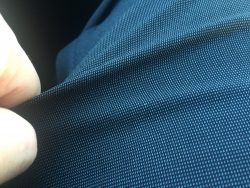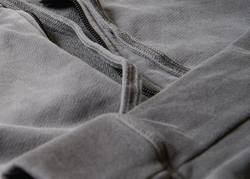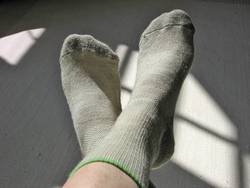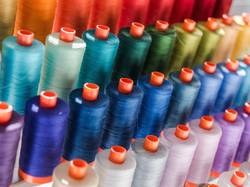How Do You Know if Fabric Is 100 Cotton
Cotton wool is still king. It is soft, comfortable, and feels like an old friend when broken in. Plus, information technology is cheaper than silk and some other fine fabrics while not losing any of its skilful looks. Nigh days, nothing beats 100% cotton fiber when yous want to sit down and relax after a hard day.
How to tell if cloth is 100 cotton wool? With 56% of all fabrics containing some course of cotton fiber, it is important o make sure that your 100% cotton shirt or dress is actually made of 100% cotton wool. The burn test is one of the easiest ways to tell if you lot take a blend or pure cotton fiber habiliment.
That is the easiest way to tell as cotton doesn't melt or scroll away from the flame of a candle, lighter, or a match. To find out other ways to tell if you have 100% cotton wearable just continue to read our article. It has the information you need to know about to make sure you are wearing nil but pure cotton.
Is There a Way to Tell if a Fabric is 100 Cotton wool?

Yes, in that location is and it is called the burn test. But at that place is ane slight problem with burning the fabric to check to see if information technology is cotton or not. That problem is that almost all-natural fibers and some semi-natural ones all burn in the same way cotton wool does. Those fabrics are Flax, hemp, jute, ramie, etc. Wool, all varieties, and silk practise not burn as cotton does.
That means that if you use the burn test, you will simply find out that you have a natural material or semi-natural textile on your hand. The label will have to be read to brand sure your outfit is 100% cotton.
All types of wool and silk tend to shrink from the flame as constructed materials will but they volition not melt. When you burn cotton you should get a newspaper-like scent or the same aroma that comes from burning leaves or wood. Silk and wool have a heavy scent that is equal to smelling called-for hair.
The reason for this difference is that cotton wool and similar products come from plants and wool and silk come from animals or insects. The two types of natural materials accept different compositions and react differently to fire.
How Can You lot Tell if a Fabric is Cotton by Touching?

I fashion to do this is not to use your hands. Rub the material gently beyond your cheek and meet how the material feels confronting such soft skin. Cotton should feel softer than other materials plus have more texture than polyester.
A polyester cotton cloth will be smoother and slicker than cotton 100% cotton volition be. Then an all poly wearable item will accept a more artificial feel well-nigh information technology. It may be hard to tell when you are trying to figure out since the manufacturing of fabrics has been upgraded over recent decades.
Sometimes the only manner to tell is by reading the label. 100% cotton wool should accept a different feel than other fabrics including natural ones merely that may non always exist the case. Cotton comes in and then many different styles and textures, similar canvas or calorie-free to heavyweight materials, that information technology will have a different feel even when comparison unlike 100% cotton items.
Don't be upset if you are fooled when you do the affect test. Information technology is getting hard to tell the difference just by touch on lonely. Manufacturers create synthetic products simply to experience and act like cotton.
How Can Y'all Tell the Difference Betwixt Cotton wool and Polycotton?

The standard test everyone talks about is the burn examination. This is where you have a few threads or some scrap fabric and put a flame to them. if the material is fabricated from polycotton, you should encounter curling or melting of the cobweb plus there should be a goo similar a balance left behind when the cloth is burned up.
Cotton fiber does not curl up just stays straight as it meets the flame. Then information technology burns like newspaper or forest, smells similar that also, and when information technology is totally consumed by fire, information technology should get out grayish blazon ash behind.
If you have lots of fourth dimension to notice out which fabric y'all own, you can e'er wear the material and meet which ones break down the fastest. Cotton is not every bit durable as polycotton. Or if you do not have the time to wait, try to rip a fragment. Cotton tears easier than polycotton volition.
The reason other fabrics are blending with cotton fiber is that it has several weaknesses. That ways that the touch test may throw you off as polycotton may experience exactly similar 100% cotton fiber. You would accept to have a fairly sensitive affect to know the departure.
How to Tell if Socks are Cotton fiber

If you oasis't done and practice not want to do the fire test, which is not always the best choice to take, you tin can use dissimilar techniques to acquire if your socks are 100% cotton or not. The first step is in how they experience confronting your skin.
If the cotton is pure it should take a different texture than polycotton or other blends, plus, it should feel softer than those other sock varieties. Next, you can wet the socks and let them dry. Cotton tin can take a very long time to dry and polyester or other blended socks should dry faster than 100% cotton.
When those tests exercise not produce the results you want, yous can wear the socks and meet how hot your feet get. Cotton breathes improve than almost whatsoever other fabric, including a poly-cotton blend. The coolness of your feet should tell you if you have 100% cotton wool on or non.
Too, polycotton or polyester do not absorb moisture equally well as cotton will. Wet the socks and see how well the h2o is absorbed into the textile to see which 1 you lot have. Finally, the toll of the socks volition permit you know which fabric y'all have as polyester is ordinarily cheaper than cotton fiber.
How to Tell if a Thread is Cotton fiber

This is where you get to the gilded standard of tests and employ a flame. That flame tin come up from a lucifer, a lighter, or a candle. Anything rubber to hold in one hand while you move the textile closer to the flame with the other.
In an before section, we gave you lot the burn down properties of cotton and other fabrics and if you see grayish ash afterwards the flame has consumed the thread. Also, if you smell a burnt paper, burnt leafage, or burnt wood odor then you have a cotton fiber thread.
Or yous may have hemp, jute, and other fabrics that come from plants. That is the hitch in the burn examination that does not make it a good examination unless you lot are trying to make up one's mind if you are using a natural fiber or a synthetic one.
The cotton thread will remain straight as it enters the flame. It will not gyre away like wool and silk fibers will or melt like synthetic ones. The remains volition be ash, not a residue or goo that comes from melting petroleum products.
How to Place Cotton Cloth by Touching (Without Burning)
The best way to touch the fabric is to gently rub the material across your cheek. Cotton wool is very soft, has a natural feel to it, and should take a little texture to the overall material. Polyester and other synthetic fabrics will have an artificial feel to it and may exist rougher than cotton.
Hither are a few of the characteristics you will discover when touching unlike fabrics:
- Cotton wool - can feel stiff but you tin can crush information technology with your fingers and put a crease into it.
- Silk- very smooth, accept a bright and luster look to the cloth.
- Wool- is coarse to the touch and you should feel protruding fibers from the fabric.
- Polyester and rayon - shine to the impact, have a luster to their look.
- Twill - coarse to the impact and there should be a diagonal feel to the material.
- Nap materials like velvet and pile - shine when touched but comes with loops and a hairy structure.
- Nylon and satin - very slippery and reverberate light.
That gives y'all an idea of the differences between the fabrics when you touch them.
Some final words
Cotton wool has its softness to help you tell the difference between it and blends or other 100% fabrics. When in doubt you can always utilise the burn down test to make sure. But the different tests are limited equally manufacturing of fabrics have greatly improved over the years.
What used to exist easy to do is at present a little more than difficult and disruptive. The all-time thing to exercise is to trust the label and get by what information technology says.
Source: https://sewingiscool.com/how-to-tell-if-fabric-is-100-cotton/
0 Response to "How Do You Know if Fabric Is 100 Cotton"
Post a Comment